Automating SOLIDWORKS PDM Professional with GoExpress
SOLIDWORKS PDM Professional is a powerful document management tool. Collaboration, version control, revision control, change history, and access control are just some of the many features of PDM. Some of these features can be automated by Dispatch, an add-in provided with PDM. Automation can also be achieved by API written in C++, C#, or Visual Basic. However, Dispatch and in-house API can have their challenges [it does all kinds of things]:
- Dispatch is very limited in what it can do.
- Troubleshooting Dispatch can often be complicated.
- Dispatch either works or fails without any error messages.
- When the author of the in-house API leaves the company, upgrading PDM becomes a challenge.
If the out of the box options can be so problematic, then there has to be a better solution. Enter GoExpress.
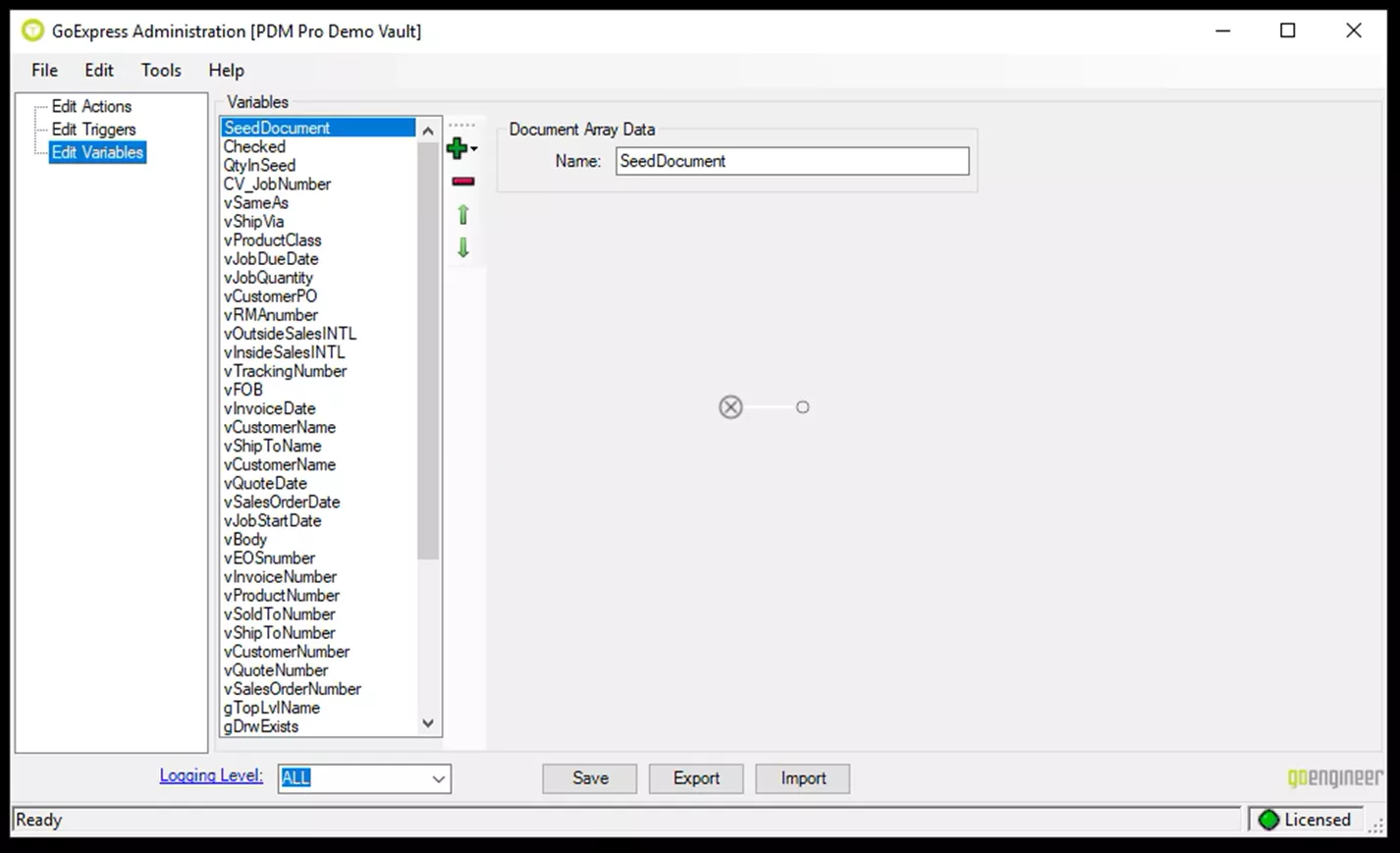
What is GoExpress?
Simply put, GoExpress is an add-in for SOLIDWORKS PDM Professional that provides an API structure. GoExpress requires .NET Framework 3.5, .NET Framework 4.x, and a PDM Professional vault view.

GoExpress, being an API structure, means the possibilities are limitless. Do you want to connect to an external database? Do you want all of your drawings stitched into a single drawing packet? Maybe you want something else entirely. Regardless, GoExpress provides the framework to automate your SOLIDWORKS PDM environment.
Now that we know what GoExpress is, how exactly does it work? GoExpress needs a configuration file for each task you want to automate. Those configuration files are provided by GoEngineer and contain instructions comprising of three key elements:
- Actions – Perform a task or tasks through a series of modules.
- Triggers – Pxecute Actions in response to a specific PDM event, such as a workflow transition.
- Variables – Temporary placeholders for pieces of data used by Actions.
These elements are part of the configuration and saved in the configure utility.
Actions
Actions have one or more Action Items, known as modules, designed to perform a specific task within an Action. In the example below the Action is “–Copy PDFs”. The Action Items are Find Related PDFs, Get Latest, and Copy PDF to temp.

Triggers
Triggers are events in PDM that can cause a trigger to launch an Action. These can include but are not limited to, Add Document, Card Button Click, Check In/Out, Copy Document, Menu Click, Serial number, or Workflow State.
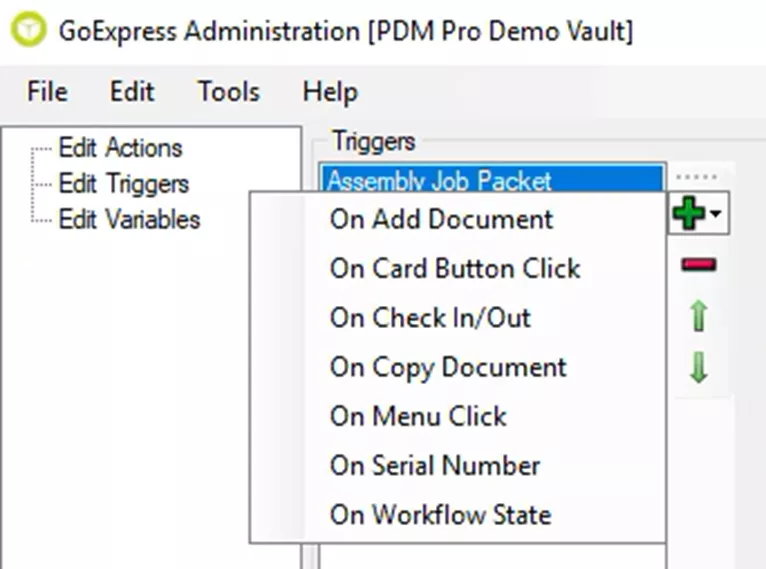
Variables
Variables can be global or fed into an array. Some variables are created when the Action Item is created. Below is an example of variables seen in the configure utility.
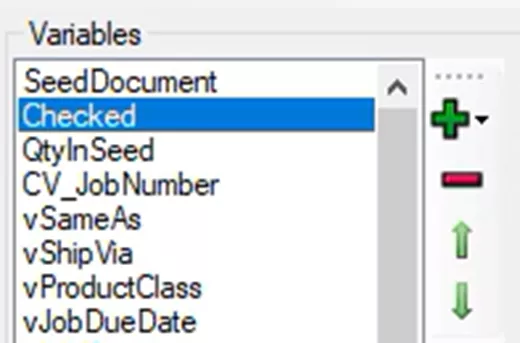
How Can GoExpress Enhance Your SOLIDWORKS PDM Professional Environment?
GoExpress has several quick-to-configure solutions that can easily be implemented in your PDM environment. Here are a few examples.
Automatically Create an ECO with References
With PDM Professional you can create a template to copy a blank ECO document, save it to a specific vault folder location, apply a number as the filename, apply the same number as the document number, open the ECO file card for additional use input, and auto check-in the ECO document. However, the PDM template process can present challenges:
- Launching the template is manual.
- Creating references between the ECO and the affected CAD files is also manual.
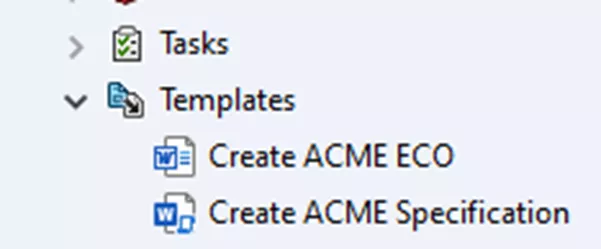
With GoExpress, you can automatically create an ECO when you transition CAD files to a specific workflow state. Additionally, you can automatically add those transitioned CAD files as references to the ECO itself, saving you the manual step. Improvements like these would make the ECO creation process more automated and useful. This is the power of GoExpress.
The ECO Creation Process with GoExpress
With GoExpress a configuration file created by GoEngineer can:
- Automatically create an ECO when CAD files transition to a specific workflow state.
- Automatically transition CAD files when the referenced ECO goes through a transition.
- Update the ECO metadata with:
- ECO number from PDM’s serial number generator
- Name of the user who performed the transition as Author or Created by
- Automatically check in the ECO
GoExpress can trigger action items like:
- Combine File List
- Create ECO
- Update List to ECO
- Add reference
- Check-in ECO when files go into a specific workflow state
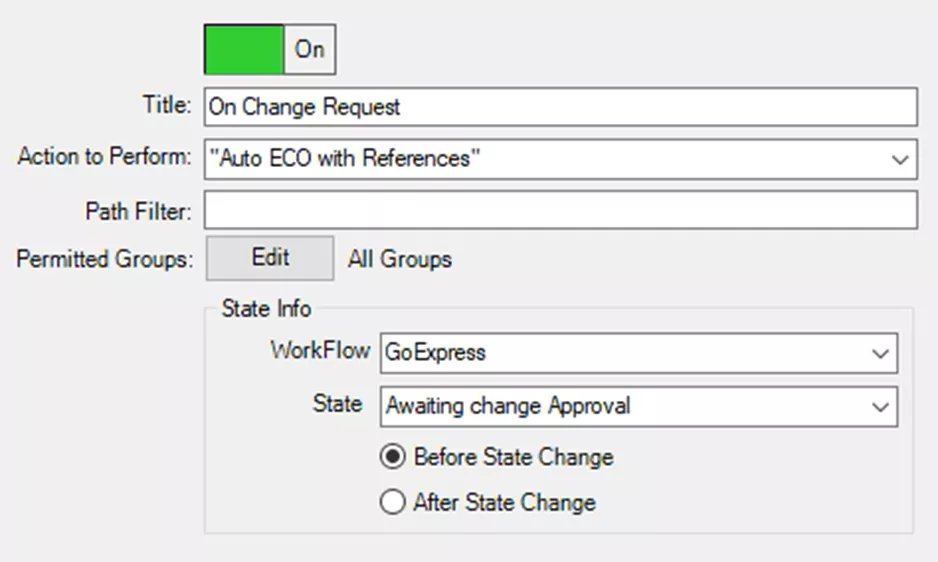
You can also apply the latest ECO Number from a PDM Serial number generator and edit the ECO variables on the file card.

Make a Drawing Packet
With PDM Professional you can save a SOLIDWORKS drawing as a PDF outside of the vault. When you select multiple drawings, the convert task creates a PDF for each SOLIDWORKS drawing. However, the PDM convert task presents a few challenges if you want multiple drawings saved into a single PDF:
- Each selected SOLIDWORKS drawing will have its own PDF file.
- Another application is required to combine multiple PDF files into a single PDF file.
- Combining the PDF files is a manual process.
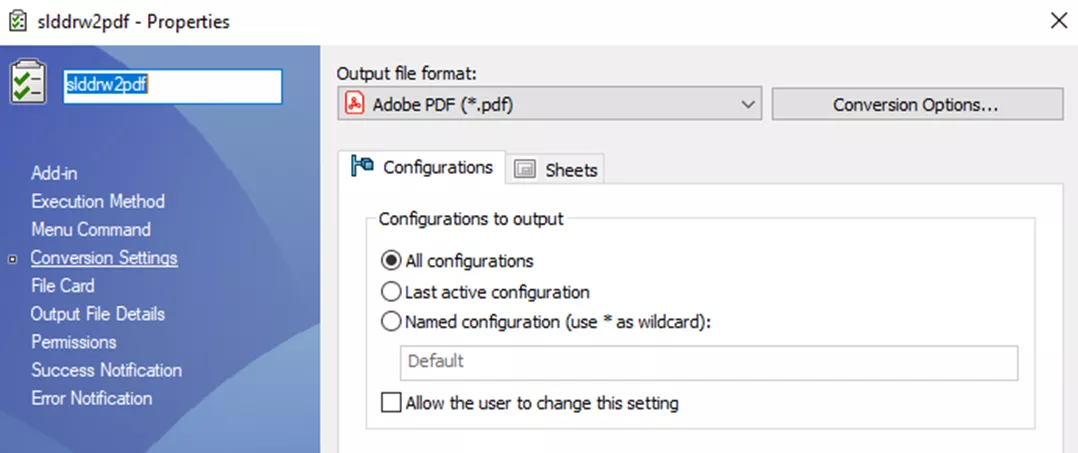
With GoExpress, you can create a drawing packet by automatically saving multiple SOLIDWORKS drawings as a single PDF outside of the vault via a workflow transition. But GoExpress goes beyond simply combining the PDFs.
GoExpress Drawing Packet Creation Features
GoExpress configuration files, as created by GoEngineer, further supplement your drawing packets by:
- Saving multiple SOLIDWORKS drawings as a single PDF automatically when they pass through a PDM transition.
- Saving a selected SOLIDWORKS assembly drawing and all selected component drawings as a single PDF with a right mouse click.
- Adding a watermark to each sheet with the drawing name and date.
- Displaying the path and filename of the PDF in a message box upon completion.
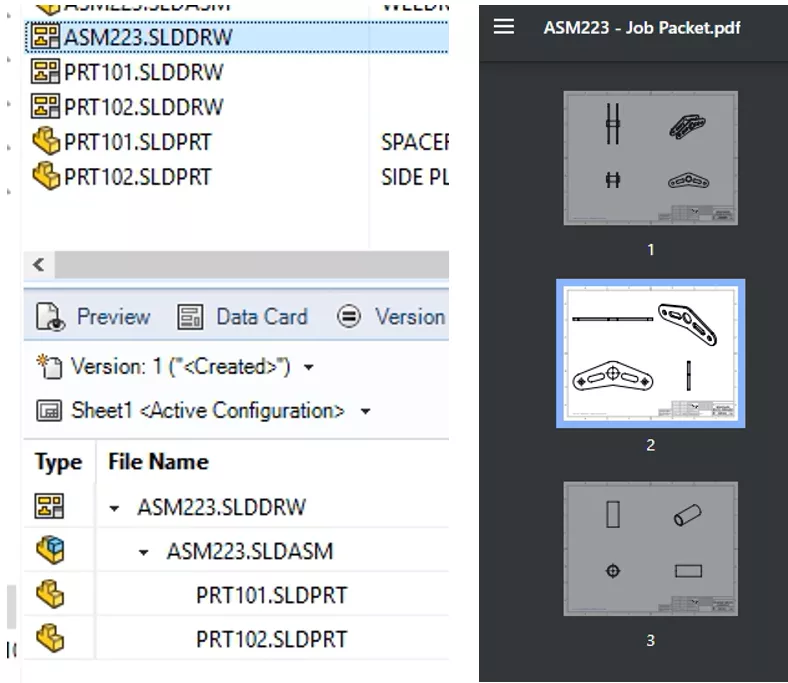
Add File References
With PDM Professional you can add file references to any document that is already in the vault. Regardless of the document type (e.g., a price list, specifications catalog, simulation results, or material data safety sheet) the process is still the same.
- Check out the parent document.
- Find the files in the vault.
- Right-mouse-click the files and select Copy.
- Go back to the parent document, right-mouse-click, then select Paste as Reference.
- Deselect Bill of Materials check box.
- Check in the parent file.
This process presents challenges, in part, because it is manual. You can easily imagine a situation where you have a bill of materials for simulation results, or you forget to check out the parent document first. This often causes frustration, even amongst the most experienced PDM users. Luckily, we can automate this process with GoExpress.
Adding File References with GoExpress
With GoExpress you can automatically check out the parent document and bring up a file selection dialog window with a right-mouse-click. The configuration file provided by GoEngineer:
- Checks out the selected document
- Opens a file selection dialog window
- Creates references to the files you selected
- Checks in the parent document
Integrate SOLIDWORKS PDM with ERP
When there is a lack of synchronization between PDM and an ERP system, information like ERP number, Description, or Status can be different between the two system and often is corrected if caught manually. With different information confusion and delays occur costing the company money.
SOLIDWORKS PDM Professional is a powerful document management tool. ERP is a powerful software system to help manage core processes and day-to-day activities. We need both systems to interact with each other, but there are a couple of challenges with this integration:
- The information needs to be synchronized between ERP and PDM
- ERP events may be needed to trigger events in PDM
There are many ways to solve how to integrate PDM with an ERP system. For this example integration, we will address a simple collection of ERP information to synchronize with PDM and an ERP event to trigger a PDM event. Here’s how to do that with GoExpress.
Synchronizing Information with PDM Coming from ERP
Inside of PDM, I will add the validation, when I transition a file to the Awaiting Approval state, I'll add the following checks:
- Validate that the Filename is the same as the Doc Number on file card
- Validate that the file card Doc Number matches what is in my ERP system
- Validate that the file card Description matches what is in my ERP system
Below is an example of a Mismatched filename and ERP Number found in PDM and ERP.

Below is an example of a Mismatched Description between PDM and ERP.

In addition to using PDM to trigger check with ERP, you can also use ERP to trigger events in PDM.
Once the ERP status for an ERP number is changed to RELEASED, the file within PDM automatically transitions from Awaiting Approval to In Production state.

GoExpress can collect information from the ERP system, like ERP number and Description, and then compare those values with file card information.
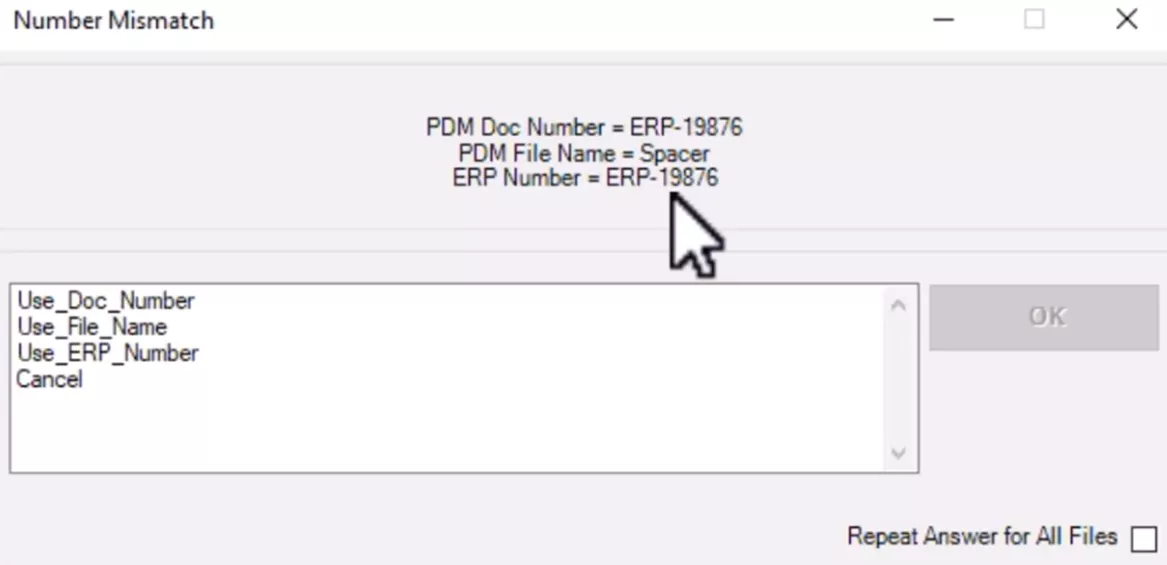
Additionally, GoExpress can have a “watchdog” process to monitor ERP Statuses. When the Status is Released and the file is in the Awaiting Approval state, GoExpress can automatically transition the file in PDM to In Production.
I hope you found this article explaining GoExpress helpful. If you have questions about this tool or about any other PDM services offered by GoEngineer, please contact us.
Related Articles
SOLIDWORKS PDM Backups: A Master List
SOLIDWORKS PDM 2025 - What's New
Configuration Properties in SOLIDWORKS PDM Data Cards
How to Create Dynamic Lists in SOLIDWORKS PDM Standard Data Cards
How to Hide a Variable in a SOLIDWORKS PDM Data Card, But Keep it Searchable

About Tom Starks
Tom Starks began using SOLIDWORKS in 2008 and PDM in 2010. He joined the VAR community in March 2014. Since then, his role has evolved from Advisory Support Engineer to Senior PDM Support Engineer, and he is now a Senior Data Management Online Instructor. Tom was awarded Elite Application Engineer in 2018. Tom teaches all online Data Management classes for SOLIDWORKS PDM and assists with Data Management Implementations.
Get our wide array of technical resources delivered right to your inbox.
Unsubscribe at any time.